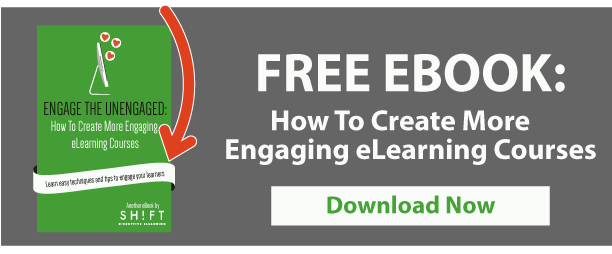Although often neglected when hiring an eLearning developer, the ability to write well is an important skill. Writing is a key part of the design procedure and equal in importance to interface design, visual design, and prototyping; however, unlike the other design aspects, which fall neatly into a timeline, writing is a continuous process.
Writing for effective eLearning is a skill that goes beyond the ability to write in an explanatory and persuasive manner, sometimes on very technical subjects; developers also need to write in-depth about subjects on which they may previously have had very limited knowledge. Furthermore, developers must find the right balance between conveying important concepts and keeping the learning interesting.
Use these six secrets of professional writers to make your eLearning content stand out and engage and interest the learner.

1. Keep sentences short.
Short sentences are always preferable to long ones. Through short sentences, the writer achieves the goal of facilitating the learning process. They make it easier to follow each point of an argument or story. Besides, less text makes it easier for learners to concentrate. Having less material to consume makes it easier for them to judge, analyze and make sense of what they are reading. Long, complex sentences, on the other hand, impede understanding and may demotivate learners.
2. Focus on brevity.
The common saying “Less is more” is especially true when it comes to writing copy for an eLearning interface. As a general rule, experts recommend online text should have half as many words as print text.
In the famous words of William Strunk Jr.: Omit needless words. This tip goes hand in hand with the short sentences rule and involves two things:
- Knowing what to write. In terms of creating an effective eLearning course, this means determining what the learner needs to know and leaving out everything else.
- Knowing how to write. The writer should use the bare minimum of words needed to convey a message. This is for two reasons: firstly because learners have limited time to spend on eLearning materials and want only to find the information they need before moving on; eLearners are not looking to read for pleasure. Secondly because there is limited space for text within the course.
3. Ensure content is understandable.
Effective eLearning courses are simple and intuitive. By creating content that is easily understood yet engaging, the learner begins reading without even noticing. For eLearning developers, this means using accessible vocabulary and terms that students who are not already well-versed in the field will understand. In short, they should just follow George Orwell's famous rule: "Never use a foreign phrase, a scientific word or a jargon word if you can think of an everyday English equivalent".
Here're 8 basic questions to help determine whether a piece of content is understandable. Every eLearning developer should ask these questions when developing content that doesn’t cause cognitive overload or understandability issues.
4. Write for the scanning eye.
Reading a screen is harder on the eyes than reading paper — an important factor to take into consideration when writing for eLearning. Thus, developers need to make the content scannable by using descriptive headings in bold text, adding visual cues, and choosing appropriate type size, color, and font. Also, developers should avoid distracting learners by keeping in-text links to a minimum.
After all, web writing is highly visual. If the screen doesn’t attract and invite the eye, no one would read it. Writers can create easily readable content by paying close attention to layout; for instance, using plenty of white space through short paragraphs and bullet point lists whenever appropriate.
There's still a lot we don't know about screen-based reading. But we do know some important behavioral changes emerging in the digital environment. These could definitely impact how we write for eLearning. Here are four revealing facts on how learners read on screen. Remember, if we really want people to pay attention to our content, it's not the reader who has to change. It's us, the authors.
5. Favor the active voice.
Whenever possible, the writer should give preference to the active voice, where the subject of the sentences performs the action. This not only helps audience understand content, it is also more precise and uses less words. While the passive voice sounds weak and timid, the active voice takes charge.
- Tips and Tricks for Using the Active Voice
- Active Versus Passive Voice Tutorial
- Podcast: What makes a good sentence a damn good sentence
6. Proofread, and then proofread again.
Learners expect their eLearning courses to be flawless; a minor spelling error, typo, or grammar mistake is enough to diminish the credibility of content. Although everyone makes mistakes, there are a few ways to avoid falling into such a trap:
- Proofread. This is the most important point. After the first draft, it is highly likely that will be a couple mistakes in the content and a few sentences that the writer could word better.
- Read the content out loud. After an initial proofreading, reading aloud is a great way for the writer to examine the content more carefully and avoid skipping over a mistake.
- Use online tools. There are various tools on the Internet for checking grammar and spelling if the writer is unsure about certain words or phrases.









